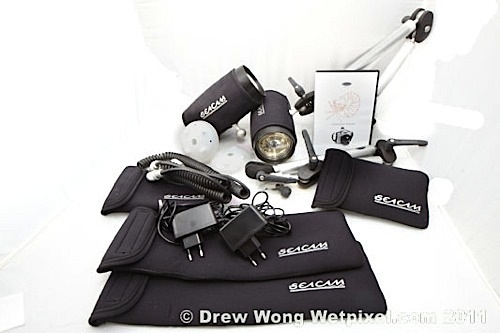Seacam Sea Flash 150 Digital Review

Seacam Seaflash 150D
*This review was done as part of the Seacam Prelude 60D review. However due to space constraints, I decided to make it a separate review as I think the Seaflash 150 strobes deserves to stand on its own as a product.
Background:
Canon’s ETTL system evolved from the ATTL and the 2nd generation ETTL II came out in 2004. Without the history of a Nikonos line and the sync protocols for underwater strobes, Canon users lacked the ability to use the ETTL system and rear-curtain sync for underwater housings. For one thing, ETTL required 6 pin connectors instead of the Nikonos 5 pin. Canon also built the ETTL circuitry into their Flash like the EX series, and like any company, was very protective of their proprietary TTL system secrets.
A few companies like Metz and Sigma reverse-engineered to make compatible flash systems so it was a matter of time before someone did the same for the underwater strobes. Ikelite was the first to crack the Canon ETTL code for their Substrobe system around 2003. However, one had to use Ikelite housings as well since part of the circuitry was in the housing.
Then a company named Heinrich Weikamp came up with an ETTL converter for digitally compatible strobes. The Heinrich Weikamp converters had 2 models, an internal that is installed as part of the hotshoe system inside the housing and one external model, which is a dongle. The dongle has been discontinued.
Sea & Sea’s YS-55 TTL/E was the first integrated strobe with ETTL compatibility built into the strobe. It was a low powered 55W strobe and has been discontinued. Sea & Sea has since moved on to using an external converter (OEM Heinrich Weikamp) to obtain ETTL with their own S&S 6pin connector.
Seacam’s first ETTL offering was the Seaflash 250, a 250W strobe with ETTL built into the strobe so it’d be compatible with any Canon housing with a S6 sync plug and fully 6 pin connection. It allowed ETTL metering and rear curtain sync (aka 2nd curtain) and was firmware updateable (has to be sent back to Austria for that).
It was a very nice strobe (I had one for ETTL before it was stolen) but one of the criticisms of the 250 was that the battery couldn’t be removed easily. This meant that the battery had to be recharged after each use, hindering repetitive multiple dives.
Another issue was one affecting everyone who travelled by air, weight and bulk in the age of airlines restrictions on baggage weight. Furthermore, with DSLRs developing very clean files up to ISO800, powerful strobes weren’t required for the typical reef dives that are common place.
In 2008, Seacam came out with the Seaflash 150, a 150W version of the 250 but with removeable batteries. It also sported a 180lumen LED spot light. Coverage is 130° (one has to remove the macro ring) and a recycle time of 2 seconds at full dump. The new design was clearly aimed towards making everything smaller, including the new charger. Although there’ve been a few posts on Wetpixel, there hasn’t been an actual test of the Seaflash 150. So I thought I’d separate it from the Seacam Prelude 60D review.
FTC Disclosure: The Seacam equipment were kindly supplied by Harald Hordosch of Seacam for the test. They were returned to Seacam after the test.
Thanks to:
Harald Hordosch of Seacam for the loan of the test equipment
David and Sanah of Scubacam Singapore for providing logistics
Patrick Schwarz of Scuba Seraya for allowing me to take over the entire rear area for my equipment.